WASHINGTON, D.C. -- Americans, on average, say their ideal weight is 162 pounds, continuing a trend of increasing estimates of ideal weight since Gallup first asked about it in 1990. The trend in Americans' self-reported actual weight -- now averaging 176 pounds -- has shown a similar increase over time.
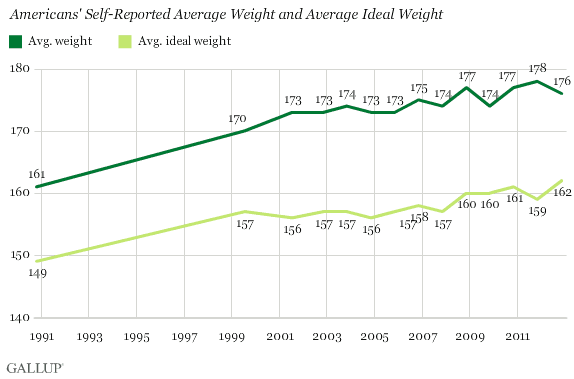
Men, on average, say their ideal weight is 185 pounds, the highest on record. Meanwhile, they report an average actual weight of 196 pounds, 11 pounds above their stated ideal.
Women, on average, say their ideal weight is 140 pounds, tying for the highest Gallup has found. They are 16 pounds away from this ideal with their average actual weight at 156.
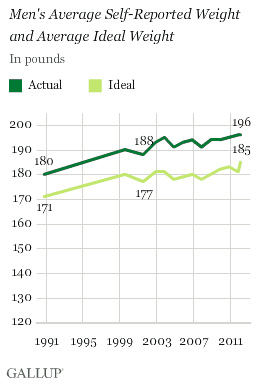
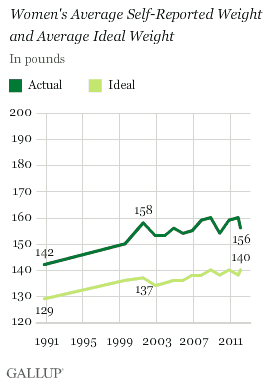
Men's average ideal weight is up 14 pounds since Gallup first measured it in 1990 and their average actual weight is up 16 pounds. Women's average ideal weight is up 11 pounds since 1990, and their average actual weight is up 14 pounds. These trends suggest that as Americans have grown heavier overall, their concept of what their ideal weight is has been adjusted upward as well.
These results are based on Gallup's annual Health and Healthcare survey, conducted Nov. 15-18. Gallup has asked Americans how much they weigh yearly since 2001, as well as in 1990 and 1999.
In total, 59% of men and 69% of women are currently over their ideal weight by one or more pounds. About one in six adults, regardless of gender, are actually at their ideal weight. Significantly more men than women are under their ideal weight by one or more pounds -- 20% vs. 7%.
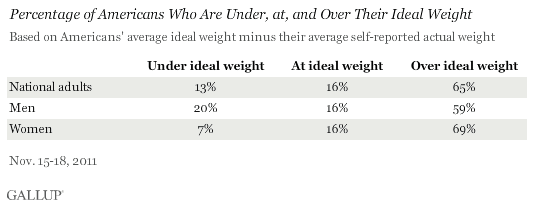
Sixty-five percent of all Americans are over their ideal weight, similar to the 67% found in the same poll last year.
Separately, Gallup and Healthways track Americans' self-reported height and weight daily to compute body mass index (BMI) scores as part of the Gallup-Healthways Well-Being Index. For comparison, these BMI calculations found that 61.9% of Americans were either overweight or obese -- 35.8% were overweight and 26.1% were obese -- in the third quarter of 2012.The majority of Americans say their weight is "about right," as they have typically responded over the past 20 years. But, the 60% who describe themselves as about right is the highest Gallup has ever found.
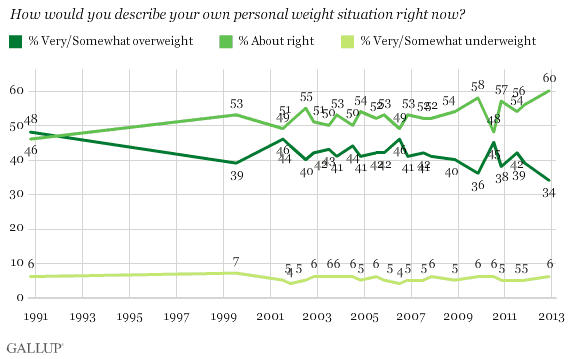
Even though the majority says their weight is about right, 54% say they would like to lose weight. However, far fewer -- 25% -- say they are seriously trying to do so, which is one of the lower readings Gallup has found in the recent past.
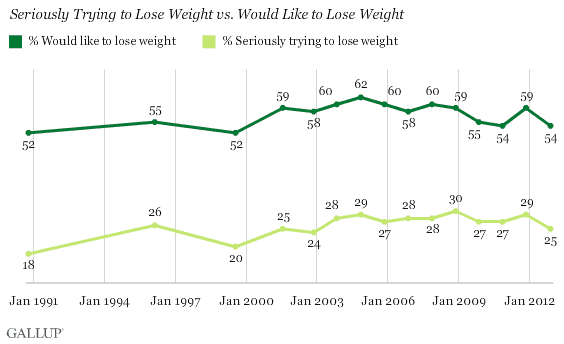
Bottom Line
Americans appear to be slowly shifting to higher weights, adjusting their expectations of what is ideal over time -- mirroring the increase in actual weight. Americans' ideal weight today is the highest on record. And more adults than ever -- 60% -- say their weight is about right, despite the number of Americans who are overweight or obese remaining near an all-time high. Underscoring Americans' weight denial is the relatively low 25% who say they are seriously trying to lose weight -- much lower than the percentage who are above their ideal weight or say they would like to lose weight.
Survey Methods
Results for this Gallup poll are based on telephone interviews conducted Nov. 15-18, 2011, with a random sample of 1,015 adults, aged 18 and older, living in the continental U.S., selected using random-digit-dial sampling.
For results based on the total sample of national adults, one can say with 95% confidence that the maximum margin of sampling error is ±4 percentage points.
Gallup surveyed 515 men and 500 women. For results based on men, one can say with 95% confidence that the maximum margin of sampling error is ±5 percentage points. For results based on women, one can say with 95% confidence that the maximum margin of sampling error is ±6 percentage points.
Interviews are conducted with respondents on landline telephones and cellular phones, with interviews conducted in Spanish for respondents who are primarily Spanish-speaking. Each sample includes a minimum quota of 400 cellphone respondents and 600 landline respondents per 1,000 national adults, with additional minimum quotas among landline respondents by region. Landline telephone numbers are chosen at random among listed telephone numbers. Cellphone numbers are selected using random-digit-dial methods. Landline respondents are chosen at random within each household on the basis of which member had the most recent birthday.
Samples are weighted by gender, age, race, Hispanic ethnicity, education, region, adults in the household, and phone status (cellphone only/landline only/both, cellphone mostly, and having an unlisted landline number). Demographic weighting targets are based on the March 2010 Current Population Survey figures for the aged 18 and older non-institutionalized population living in U.S. telephone households. All reported margins of sampling error include the computed design effects for weighting and sample design.
In addition to sampling error, question wording and practical difficulties in conducting surveys can introduce error or bias into the findings of public opinion polls.
View methodology, full question results, and trend data.
For more details on Gallup's polling methodology, visit https://www.gallup.com/.
